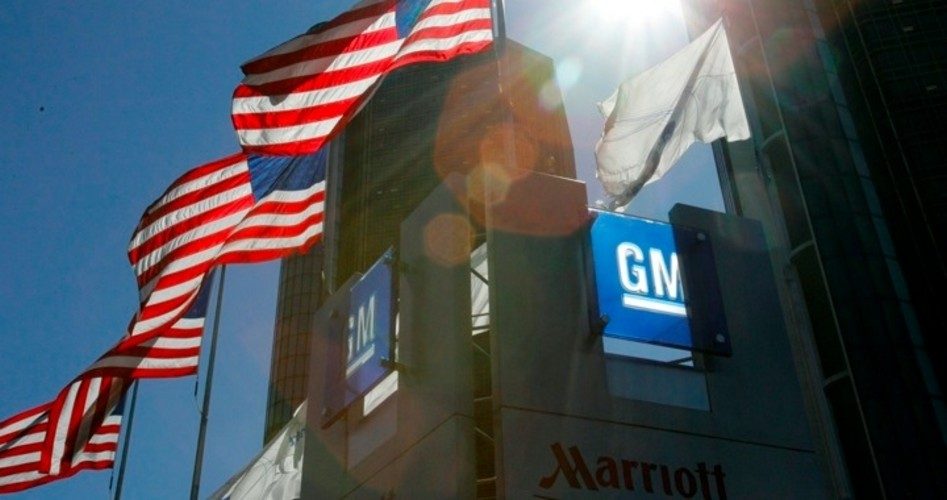
Despite surges in revenue and a catalog of new vehicles produced by the U.S. auto industry, taxpayers are still suffering from the 2009 bailouts, as General Motors (GM) would have to peddle their stock for $95.51 per share for taxpayers to break even, according to a government watchdog report published Wednesday. Even with a 25-percent spike in the price this year, that’s still well over twice what shares are selling for today, with the price currently lingering around $37 per share — meaning there’s little faith that taxpayers will break even on the nearly $50-billion GM bailout.
The inspector general for the Troubled Asset Relief Program (TARP) asserts that taxpayers are still at least $18 billion in the hole, which government officials insisted GM needed to endure its bankruptcy restructuring in 2009. Since its escape from bankruptcy, the automaker has earned about $17.2 billion, and in exchange for its federal endowment, the government secured a bulky portion of the company’s stock.
Over the past couple of years, the government has slowly been liquidating its stock, with a target to fully retire its investment by April 2014; it still owns about 189 million shares, or about 14 percent of the company. But according to many experts taxpayers will remain the ultimate losers.
“There’s no question that Treasury, the taxpayers, are going to lose money on the GM investment,” Special Inspector General Christy Romero, who delivered the July quarterly report to Congress, noted in a recent interview.
If the government sells its remaining GM shares for its current stock price, it would take in only $7 billion, putting taxpayers on the hook for more than $11 billion on the overall bailout cost. In addition to GM’s bailout in 2008 and 2009, Romero’s report continues, domestic automaker Chrysler was bailed out for $12.5 billion, which cost taxpayers nearly $3 billion.
Ally Financial Inc., which previously was GM’s lending arm, still owes taxpayers $14.6 billion, and the Treasury owns about 74 percent of that company, with an additional $5.9 billion worth of preferred stock. Ally has made only one principal payment equaling $2.5 billion since the bailout in 2009.
The Associated Press reports further on Romero’s damning report:
Overall, the government allocated $474.8 billion to the TARP program to bail out banks, insurers, auto companies and others during the financial crisis. Taxpayers are still owed $57.6 billion, the report stated. Of that, the Treasury Department has written off losses of $29.6 billion, leaving a balance of $28.6 billion outstanding.
That figure excludes $8.6 billion spent on the government’s bailout program for struggling homeowners. That money is designated as government subsidies and no repayment is expected, the report said. Romero said Treasury has yet to spend $29.9 billion available for the housing program.
Still, the federal government and other proponents of the bailout are touting the revival of U.S. automakers, indicating that taxpayer dollars were a chief component of GM and Chrysler’s reemerging presence in the marketplace. But simply paying back the debt (or, at least, portions of it) does not fully illustrate the federal government’s intervention in the industry, says Rick Newman, writing for Yahoo! Finance.
The Big Three automakers have all portrayed the federal aid as an oddity that will never happen again. Yet, Newman insists, “They’re benefiting from another set of government strategies that may be aiding their comeback just as much: The Federal Reserve’s easy-money policies, which are one of the biggest factors boosting car sales right now.” He continues:
Most analysis of Fed policies focuses on how quantitative easing — the Fed’s huge bond-buying program — has helped push stock prices to one record high after another this year. But the same policies are driving auto sales back toward pre-recession levels, even though unemployment remains high, credit is still scarce and many consumers are far more pinched than they were before the recession.
The Federal Reserve is currently implementing two forms of monetary policy to redirect the economy: Quantitative easing, which curtails long-term interest rates, and rock-bottom short-term rates, which are set directly by the Fed. Differentiating the auto industry from other sectors of the economy, Newman suggests, these forms of stimulus policy directly benefit automakers.
While the potency of the impact may be difficult to interpret, Newman’s assertion lies with the notion that low long-term interest rates have improved the housing market. Consequentially, builders and contractors have generated new business, leading to a sharp boost in pickup truck sales, which are highly profitable and have been a decisive component to rising earnings at GM, Chrysler, and Ford.
Meanwhile, Newman continues, low short-term rates have also captured the role as automaker stimulus, because rates on loans are more closely aligned to short-term rates set by the Federal Reserve. And inexpensive loans are keeping monthly payments low for car buyers, encouraging them to purchase more expensive vehicles.
But, in the end, despite the impact Federal Reserve policies might have on the auto market, the long-term impact of Fed manipulation is incriminating, as monetary stimulus — and general economic stimulus — is a chief contributor to rising inflation.
And while the Obama administration and stimulus proponents tout the impact of devious Fed policies and the Detroit bailouts, they neglect to mention the big-government spending policies of stimulus and the potentially more damaging impact of runaway inflation.
Photo: AP Images



